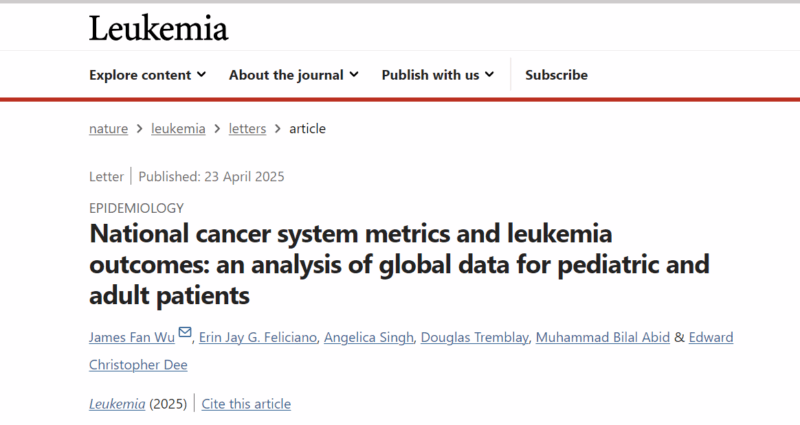James Fan Wu, Hematology/Oncology Fellow at Medical College of Wisconsin, posted on LinkedIn, about recent paper he and his colleagues co-authored:
“New publication in Leukemia:
Honored to have worked with Edward Christopher Dee, Erin Feliciano, M. Bilal Abid, Dr. Tremblay, Dr. Singh.
In 2022, with 500,000 new cases, leukemia was the top 10 cause of adult cancer death in 71 counties and the leading cause of pediatric cancer death in 96 counties.
But with many disparities, we asked what health system factors are important in improving global leukemia outcomes?
We used the most recent national health system metrics and global leukemia statistics. Estimates of pediatric and adult age-standardized mortality-to-incidence ratios (MIRs) were derived GLOBOCAN 2022.
We examined: Health spending, physicians, nursing/midwifery, RT, surgical workforce, GDP per capita, UHC index, pathology services, HDI, gender inequality, out-of-pocket expenditure, BMT services, childhood early detection program, and defined childhood referral patterns.
For pediatric leukemias, 11/13 metrics were significantly associated (p<0.001) with leukemia MIR on linear models. On multivariable analysis, only the gender inequity index was independently associated with lower (improved) pediatric leukemia MIR (model R2 = 0.6328).
For adult leukemias, all 11 metrics were associated with leukemia MIR on linear models. On multivariate analysis, the following variables were independently associated with lower (improved) adult leukemia MIR: healthcare spending, nurses/midwives, UHC Index, BMT services, GDP per capita, and out-of-pocket expenditure (model R2 = 0.7792).
In pediatric leukemia, we highlight the importance of gender equity, which has not been studied in pediatric cancer outcomes. High gender inequality limits the ability of women to act in the best interests of their children. This aligns with central messages from the The Lancet Group commissions on ‘Gender and Global Health’ and ‘Women, power, and cancer’. Gender equity and women empowerment should be key considerations in global efforts to improve pediatric leukemia outcomes. Improving pediatric oncology-specific nursing workforce and training and access to BMTsm especially in resource-limited countries remain important.
In adult leukemia, efforts need to strengthen the diagnostic and treatment capacity while also increasing adequate human resources by bolstering the oncology nurse workforce and increasing capacity for BMT globally. Universal health coverage was associated w/ improved adult leukemia outcomes potentially through mitigation of exorbitant financial toxicities secondary to cancer care. Indirect FT like food insecurity and psychosocial distress may also be mitigated by UHC.
We hope this research serves as a catalyst for global initiatives to strengthen health systems to improve leukemia outcomes.
Message for full article.”
Authors: James Fan Wu, Erin Jay G. Feliciano, Angelica Singh, Douglas Tremblay, Muhammad Bilal Abid and Edward Christopher Dee

Muhammad Bilal Abid, Assistant Professor of Medicine at Medical College of Wisconsin, shared this post, adding:
“Publication alert
An important project that systematically parses out disparities as they impact leukemia outcomes globally, both in adults and pediatrics!
Very important work providing insights for the policymakers. More details in the thread below by the PI, James F. Wu.
Congratulations to the entire team for getting this much needed work done!”
More posts featuring James Fan Wu.
